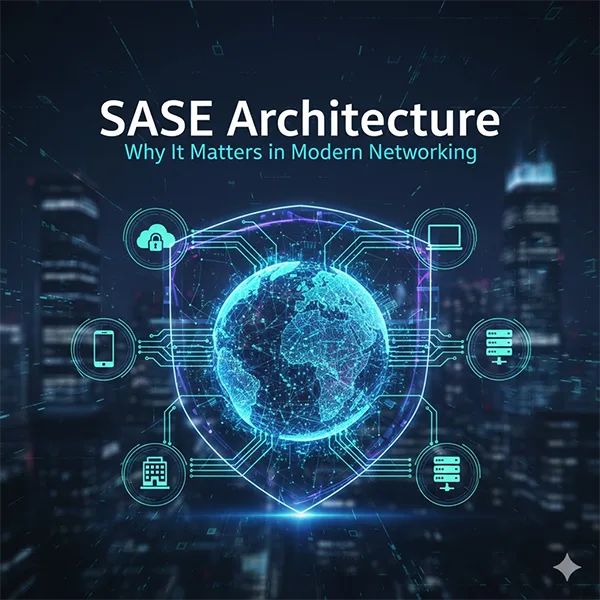
“SASE can help to improve both your network speed and your security at the same time”. Yes, you heard it right. With SASE, organizations have reported faster networks and stronger security.
The traditional ‘fast vs safe’ comparisons are now invalid. If you still haven’t found it trustworthy, look at the Fortinet reports: “61% of the organizations reported improved security and 65% reported enhanced network after adopting SASE.”
Earlier, the corporate data centre was the only guardian. But in the world of remote work, SASE (Secure Access Service Edge) has become popular for its seamless systems.
Read on to understand how SASE architecture unites security and network into one seamless system – built for speed, scalability and security.
SASE(Secure Access Service Edge) is a cloud delivered framework that provides both security and networking in a single service. It routes user traffic to the nearest SASE PoP (point of presence), where tools like firewalls and malware filters are applied at the same time.
It doesn’t force data through any central data centre. But secures it at the edge – closer to users. The result?
Faster connections, stronger protection and simplified management across offices and remote teams.
Understand it as a smart checkpoint system that travels with your data wherever it goes.
The SASE framework is based on five key pillars:
Fun Fact
Over 80% of the enterprises use at least two of these services in a cloud model – and most of them don’t realize they are already halfway to SASE.
“SASE operates on Zero Trust – which verifies every connection and trusts no one”
Every connection is verified based on identity, device and context – whether it is a user from the office, at home or on public wifi.
Like airport security, it rechecks every passenger at every terminal – even frequent flyers.
The result? Stronger security with zero attacks.
According to Gartner, around 63% of organizations either fully or partially implement a zero trust strategy.
Networking (SD-WAN) makes SASE possible. It is also termed as the networking backbone.
SD-WAN routes traffic to the nearest SASE PoP (point of presence) – ensuring the user gets minimal delay and maximum uptime.
It is like an online food delivery service that routes each order to the nearest kitchen. SD-WAN does the same for your data.
Its design makes it flexible – if one Pop fails, another one is rerouted automatically.
Let’s explore the comparison between SASE and traditional security architectures.
No matter where the data goes – AWS or Google Cloud – it’s safe with policies of SASE.
The key benefits of SASE include:
The impact isn’t just theoretical – after using SASE, Aryaka found 113% ROI and around US $2.48 NPV over a 3-year model.
Along with plenty of benefits, SASE has some challenges too:
Good news? These hurdles get away with time and experience. Early adopters like Aryaka are already enjoying tangible returns.
SASE is a game changer for:
For these, SASE is “the Netflix of networking” – scalable, on-demand and customized for user needs.
“According to a report hosted on Amazon AWS – SASE is still in its early stages and may take around 5 to 10 years to become mainstream”.
It is better to switch to SASE now – before everyone else does.
SASE isn’t just the future – it’s a smart move today. The sooner businesses adopt it, the quicker they turn complexity into control and risk into security.
The more you wait, the more it will be to untangle traditional systems.
Not really, even though it helps to reduce various operational and other costs.
Yes, it can provide the same cloud protection to small businesses too.
